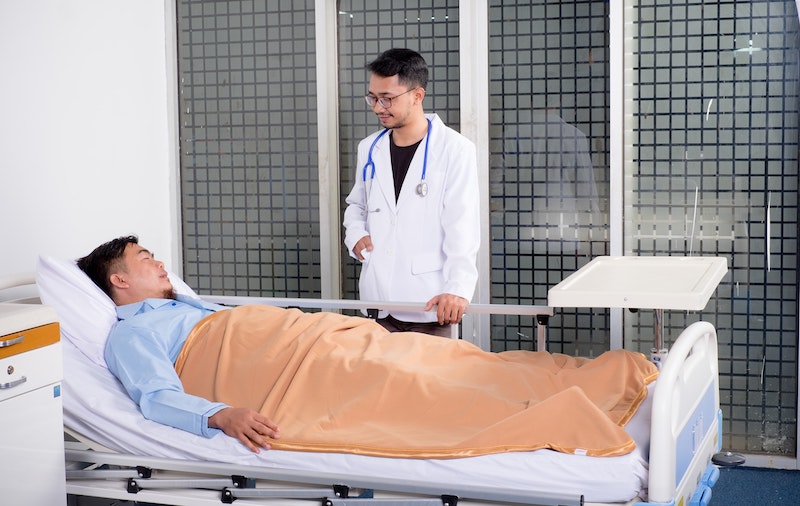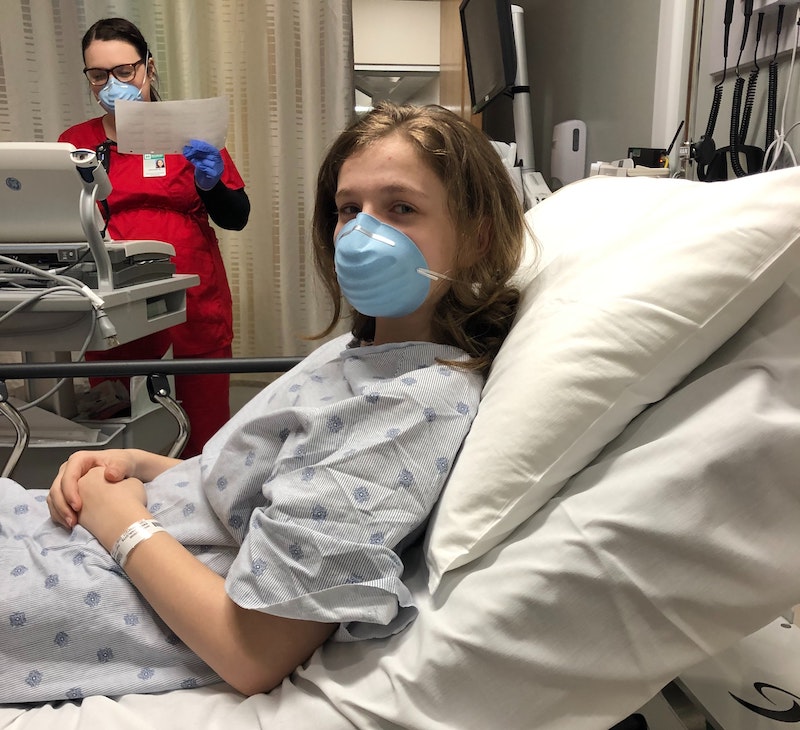In this free Medical Spanish lesson you will learn how to talk about upper respiratory infections in Spanish: Infecciones de las vías respiratorias superiores.
We will be talking about:
- Respiratory symptoms / Síntomas respiratorios
- Related Anatomy / Anatomía relacionada
- Examination and analysis / Exámenes y análisis
- Questions to rule out causes / Preguntas para descartar causas
- Common Causes / Causas comunes
- Some practice situations / Unas situaciones de práctica
Here is the Upper Respiratory Infections in Spanish lesson that I taught on YouTube and to our Facebook group:
Subscribe to our YouTube Channel to see all of our lessons and get the latest videos right away!
Síntomas respiratorios – Respiratory Symptoms
Every time you treat a patient with an upper respiratory infection, you talk through their symptoms to get the correct diagnosis. So, let’s learn the names of the majority of respiratory symptoms in Spanish and their equivalents in the English.
| Spanish | English |
| Tos Seca / Tos con flema (productiva) | Dry Cough / Cough with phlegm (productive cough) |
| Estornudo | Sneeze |
| Nariz tapada / congestión nasal | Stuffy nose |
| Goteo nasal | Runny nose |
| Fiebre | Fever |
| Dolor de garganta | Sore Throat |
| Falta de aire | Shortness of breath |
| Dolor de pecho | Chest pain |
| Dificultad para respirar | Difficulty breathing |
| Dolor de cabeza | Headache |
| Calofríos / Escalofríos | The chills |
| Dolor de los músculos | Muscle pain |
| Dolor de oído | Earache |
| Oídos congestionados | Stuffy ears |
| Dificultad para oír | Difficulty hearing |
| Silbidos | Whistling |
| Mucosa / flema / mocos • Gruesa • Amarilla • Verde • Con sangre • Clara • Cambios en la flema (color, característica) | Mucous / phlegm / mucus • Thick • Yellow • Green • With blood • Clear • Phlegm changes (color, characteristic) |
Anatomía relacionada – Related Anatomy
You often need to refer to the various body parts and organs that make up the upper respiratory system as well.
| Español | English |
| Senos nasales, frontales | Sinuses |
| Vías respiratorias | Airways |
| Conductos nasales | Nasal passages |
| Faringe | Pharynx |
| Laringe | Larynx |
| Tráquea | Trachea |
| Pulmones | Lungs |
| Ganglios linfáticos | Lymph nodes |
| Las amígdalas | Tonsils |
| Trompa de Eustaquio | Eustachian tube |
| Membrana timpánica (del tímpano) | Tympanic membrane (eardrum) |
Exámenes / Análisis para confirmar diagnósticos – Tests / Analyses to Confirm Diagnoses
Here are a couple of tests and analyses you may order to confirm the diagnosis.
| Spanish | English |
| Análisis de sangre | Blood tests |
| Cultivo de garganta – una muestra de (sangre, esputo, etc) | Throat culture – a (blood, sputum, etc) sample |
| Radiografía del pecho | Chest X-ray |
In Spanish, “cultura” is the common set of beliefs and norms that a particular group of people has. Every time you are talking about a medical definition of culture, you need to use the word “cultivo” in Spanish.
Cómo hablar de las causas – How to Talk About the Causes

Preguntas para descartar causas – Questions to rule out Causes
These questions would help you to get a clear idea about the infection: if it is a viral infection or a bacterial infection…
- ¿Hay otras personas en casa que tienen (o recientemente han tenido) los mismos síntomas?
- Are there other people at home who have (or recently have had) the same symptoms?
- ¿Cuándo empezaron los síntomas?
- When did the symptoms start?
- ¿Han cambiado? Es decir ¿mejoraron y luego empeoraron de nuevo?
- Have they changed? That is to say, did they get better and then get worse again?
- ¿Ha tenido tos productiva (con flema, sangre)?
- Have you had a productive cough (with phlegm, blood)?
- ¿Ha viajado recientemente?
- Have you traveled recently?
- ¿Ha tenido fiebre? ¿sudores en la noche? ¿escalofríos?
- Have you had a fever? Sweating at night? Chills?
- ¿Ha perdido el sentido de olfato? ¿O de gusto?
- Have you lost your sense of smell? Or your sense of taste?
- ¿Tiene apetito? ¿Puede comer? ¿O tiene falta de apetito?
- Do you have an appetite? Can you eat? Or do you have a lack of appetite?
- ¿Ha tomado algún antibiótico?
- Have you taken any antibiotics?
- ¿Ha usado / intentado / tratado algún otro tratamiento en casa?
- Have you used / tried anything else at home?
Note: Feel free to share any other question you would ask your patient in the comments bellow and we will help you to get the Spanish equivalent.
Causas comunes de problemas respiratorios – Common Causes of Respiratory Problems
Now it’s time to learn the most common causes of respiratory problems in Spanish.
| Spanish | English |
| Virus: Infección viral | Virus: Viral infection |
| Bacteria: Infección bacteriana | Bacteria: Bacterial infection |
| Influenza, gripe | the flu |
| VSR virus sincitial respiratorio | RSV respiratory syncytial virus |
| Tos ferina | Whooping cough |
| Asma | Asthma |
| Pulmonía, neumonía | Pneumonia |
| Alergias | Allergies |
| Sinusitis | Sinusitis |
| Bronquitis | Bronchitis |
| COVID-19, coronavirus | COVID-19, coronavirus |
| El catarro , el resfriado | common cold |
| Tuberculosis | Tuberculosis |
| Sarampión | Measles |
| Bronquiolitis | Bronchiolitis |
| Estreptococo de garganta | Strep Throat |
| Mononucleosis | Mononucleosis |
| EPOC: Enfermedad pulmonar obstructiva crónica | COPD: Chronic Obstructive Pulmonary Disease |
Unas situaciones para practicar… – Some situations to practice…
You can practice all of these situations with a colleague or a conversational partner. If you don’t have a partner, then your first step would be to start thinking about the vocabulary you need and the questions you would ask a patient in any of these situations, so that you will be ready to talk with a Spanish speaking patient in your clinic.
Situación 1:

Mujer de 23 años tiene congestión nasal, fiebre y dolores de cabeza por 4 días.
23-year-old woman has had nasal congestion, fever and headaches for 4 days.
Situación 2:
Niño de 8 años tiene estornudo, dificultad para respirar, y goteo nasal. Está peor cuando juega con amigos y se esfuerza.
Eight-year-old boy has sneezing, difficulty breathing, and a runny nose. He’s worse when he plays with friends and strains.
You can get two extra practice situations by downloading our .pdf notes
Now it’s your turn! I packaged all of this vocabulary in Spanish into some flashcards for you to study.
Keep up the good work speaking responsible Spanish to your patients! Check out our other books, classes & products to help you learn medical Spanish!
*If the link isn’t working for you, you may need to unblock pop-ups in your browser settings
If you’re ready for your next step with Spanish, join us in August. In this free course you’ll learn how to:
- Take a medical history in Spanish
- Conduct a physical exam in Spanish
- Give discharge instructions in Spanish
- Walk away with a Medical Spanish Master Blueprint for how you can keep your Spanish moving forward week by week without backsliding and without getting rusty.




